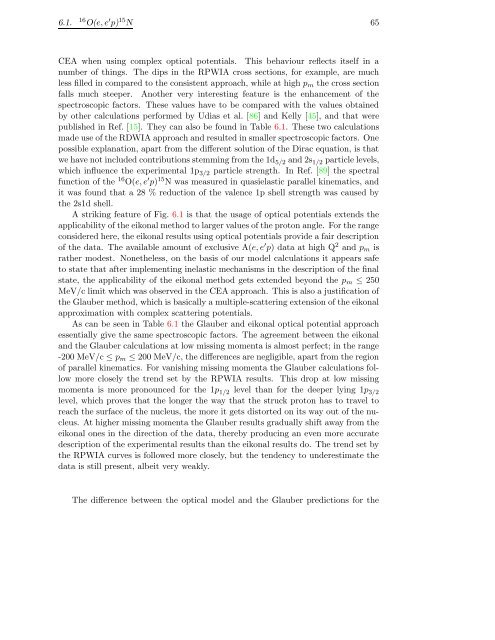Download Thesis in Pdf Format - Theoretical Nuclear Physics and ...
Download Thesis in Pdf Format - Theoretical Nuclear Physics and ...
Download Thesis in Pdf Format - Theoretical Nuclear Physics and ...
Create successful ePaper yourself
Turn your PDF publications into a flip-book with our unique Google optimized e-Paper software.
6.1. 16 O(e, e ′ p) 15 N 65<br />
CEA when us<strong>in</strong>g complex optical potentials. This behaviour reflects itself <strong>in</strong> a<br />
number of th<strong>in</strong>gs. The dips <strong>in</strong> the RPWIA cross sections, for example, are much<br />
less filled <strong>in</strong> compared to the consistent approach, while at high p m the cross section<br />
falls much steeper. Another very <strong>in</strong>terest<strong>in</strong>g feature is the enhancement of the<br />
spectroscopic factors. These values have to be compared with the values obta<strong>in</strong>ed<br />
by other calculations performed by Udias et al. [86] <strong>and</strong> Kelly [45], <strong>and</strong> that were<br />
published <strong>in</strong> Ref. [15]. They can also be found <strong>in</strong> Table 6.1. These two calculations<br />
made use of the RDWIA approach <strong>and</strong> resulted <strong>in</strong> smaller spectroscopic factors. One<br />
possible explanation, apart from the different solution of the Dirac equation, is that<br />
we have not <strong>in</strong>cluded contributions stemm<strong>in</strong>g from the 1d 5/2 <strong>and</strong> 2s 1/2 particle levels,<br />
which <strong>in</strong>fluence the experimental 1p 3/2 particle strength. In Ref. [89] the spectral<br />
function of the 16 O(e, e ′ p) 15 N was measured <strong>in</strong> quasielastic parallel k<strong>in</strong>ematics, <strong>and</strong><br />
it was found that a 28 % reduction of the valence 1p shell strength was caused by<br />
the 2s1d shell.<br />
A strik<strong>in</strong>g feature of Fig. 6.1 is that the usage of optical potentials extends the<br />
applicability of the eikonal method to larger values of the proton angle. For the range<br />
considered here, the eikonal results us<strong>in</strong>g optical potentials provide a fair description<br />
of the data. The available amount of exclusive A(e, e ′ p) data at high Q 2 <strong>and</strong> p m is<br />
rather modest. Nonetheless, on the basis of our model calculations it appears safe<br />
to state that after implement<strong>in</strong>g <strong>in</strong>elastic mechanisms <strong>in</strong> the description of the f<strong>in</strong>al<br />
state, the applicability of the eikonal method gets extended beyond the p m ≤ 250<br />
MeV/c limit which was observed <strong>in</strong> the CEA approach. This is also a justification of<br />
the Glauber method, which is basically a multiple-scatter<strong>in</strong>g extension of the eikonal<br />
approximation with complex scatter<strong>in</strong>g potentials.<br />
As can be seen <strong>in</strong> Table 6.1 the Glauber <strong>and</strong> eikonal optical potential approach<br />
essentially give the same spectroscopic factors. The agreement between the eikonal<br />
<strong>and</strong> the Glauber calculations at low miss<strong>in</strong>g momenta is almost perfect; <strong>in</strong> the range<br />
-200 MeV/c ≤ p m ≤ 200 MeV/c, the differences are negligible, apart from the region<br />
of parallel k<strong>in</strong>ematics. For vanish<strong>in</strong>g miss<strong>in</strong>g momenta the Glauber calculations follow<br />
more closely the trend set by the RPWIA results. This drop at low miss<strong>in</strong>g<br />
momenta is more pronounced for the 1p 1/2 level than for the deeper ly<strong>in</strong>g 1p 3/2<br />
level, which proves that the longer the way that the struck proton has to travel to<br />
reach the surface of the nucleus, the more it gets distorted on its way out of the nucleus.<br />
At higher miss<strong>in</strong>g momenta the Glauber results gradually shift away from the<br />
eikonal ones <strong>in</strong> the direction of the data, thereby produc<strong>in</strong>g an even more accurate<br />
description of the experimental results than the eikonal results do. The trend set by<br />
the RPWIA curves is followed more closely, but the tendency to underestimate the<br />
data is still present, albeit very weakly.<br />
The difference between the optical model <strong>and</strong> the Glauber predictions for the















